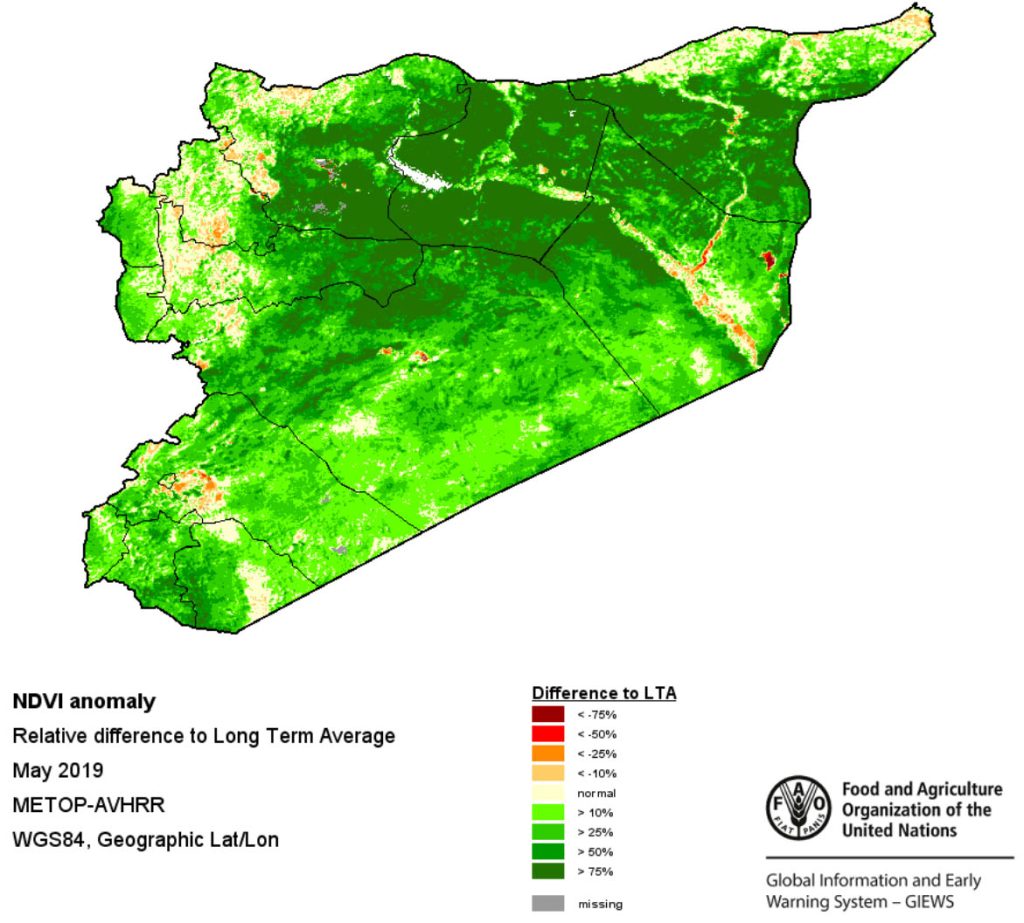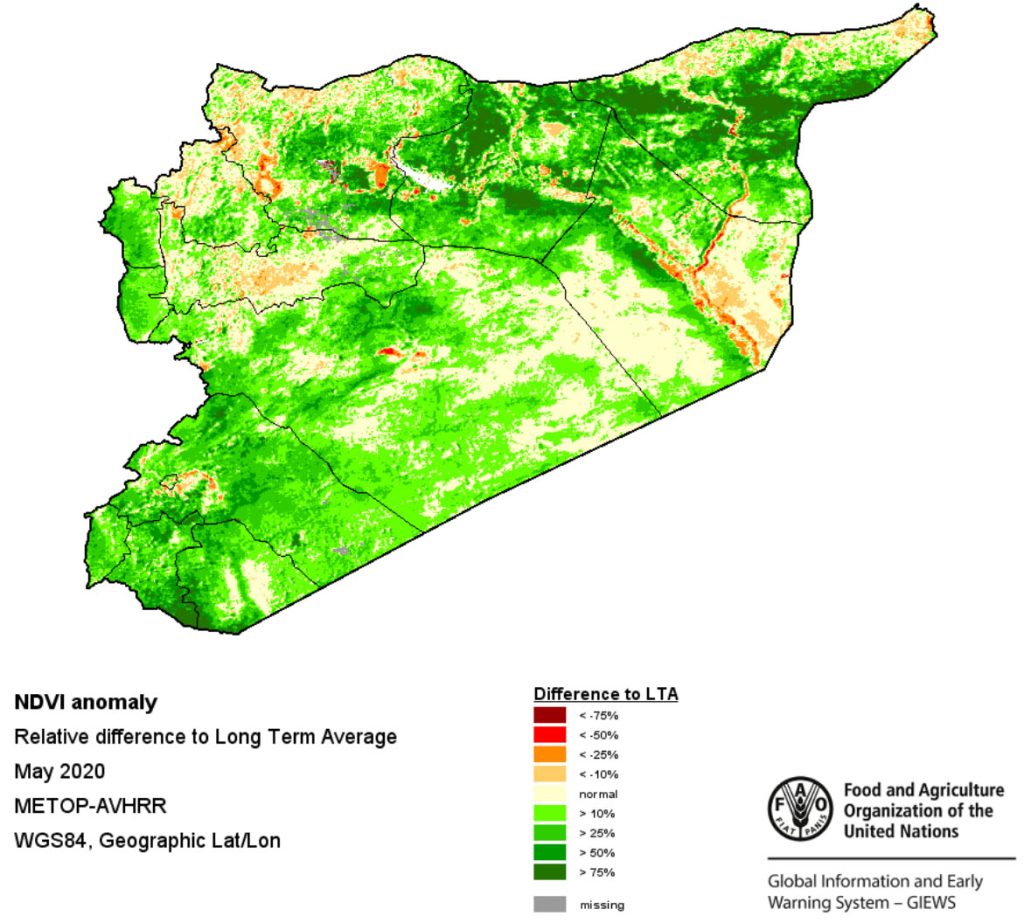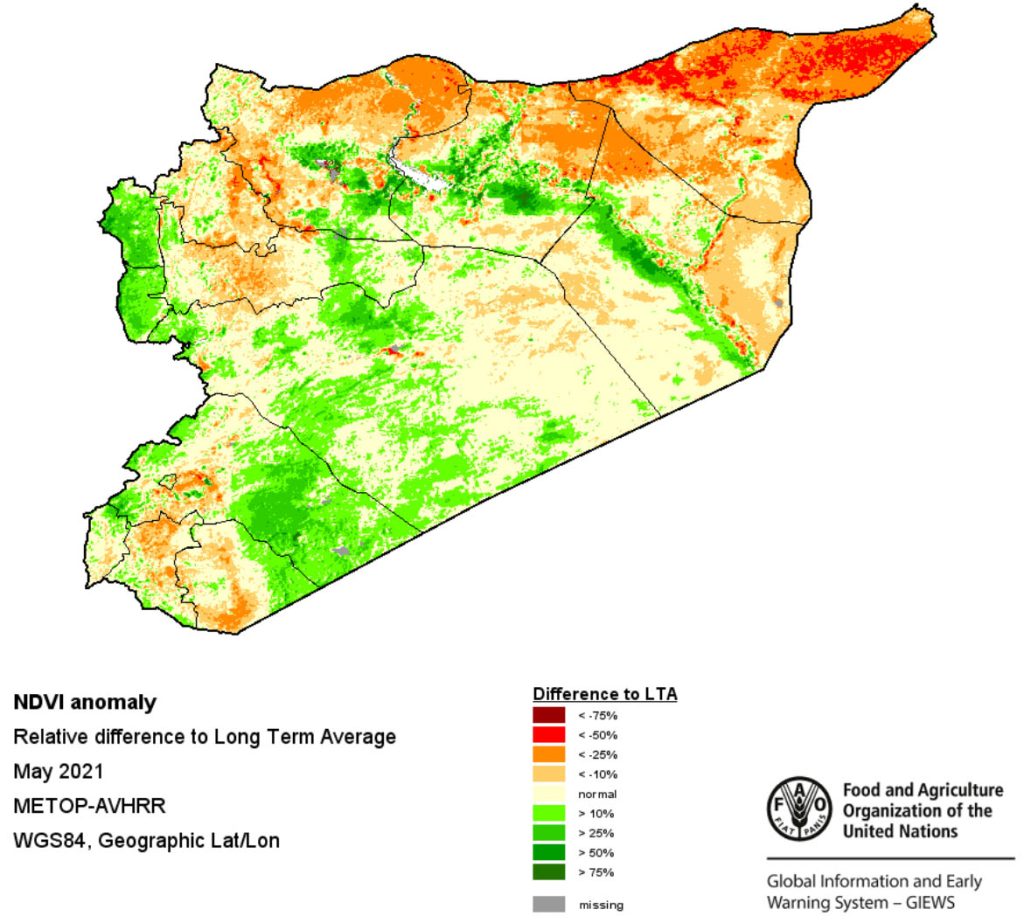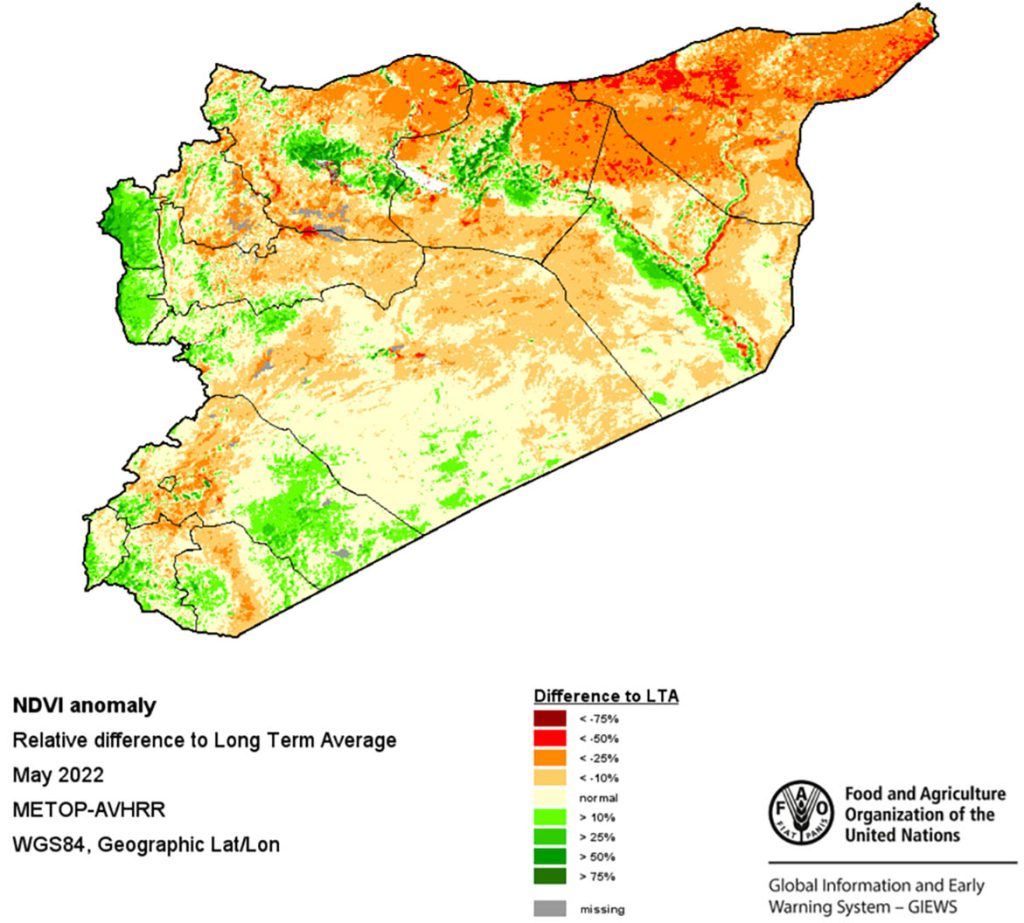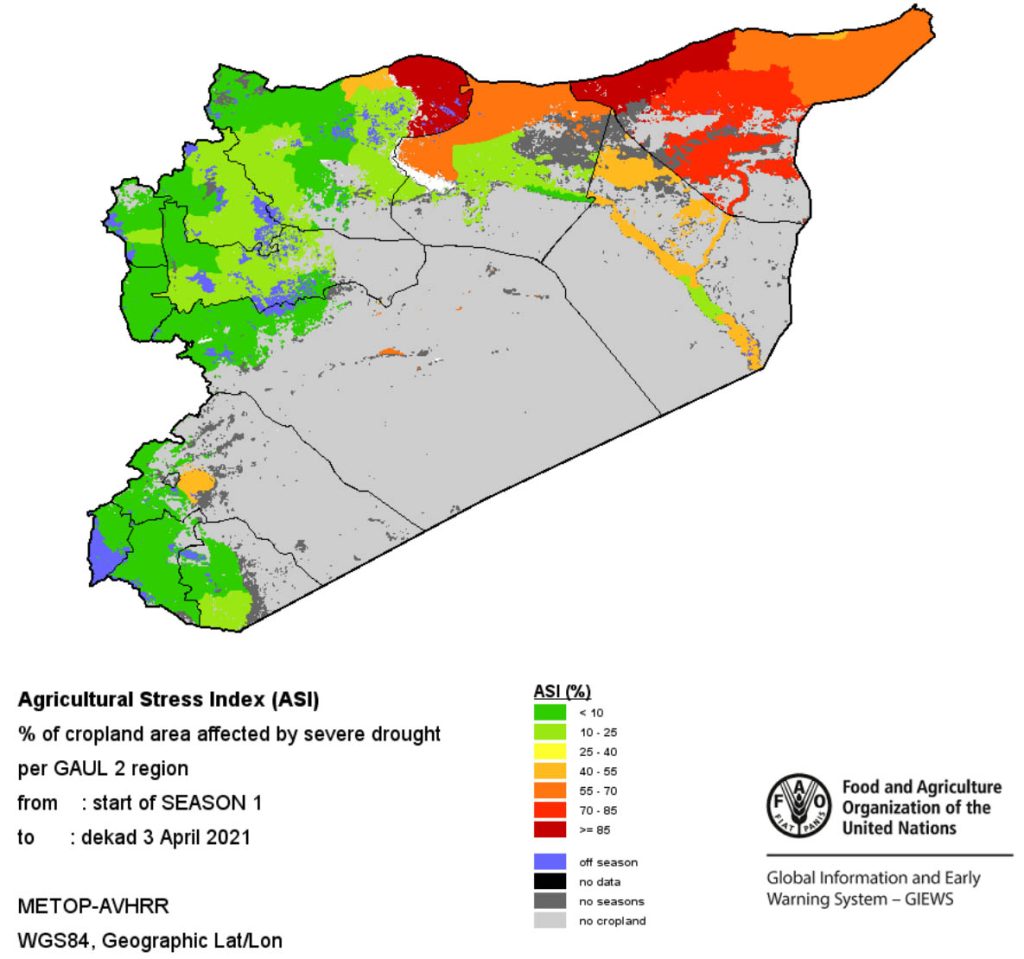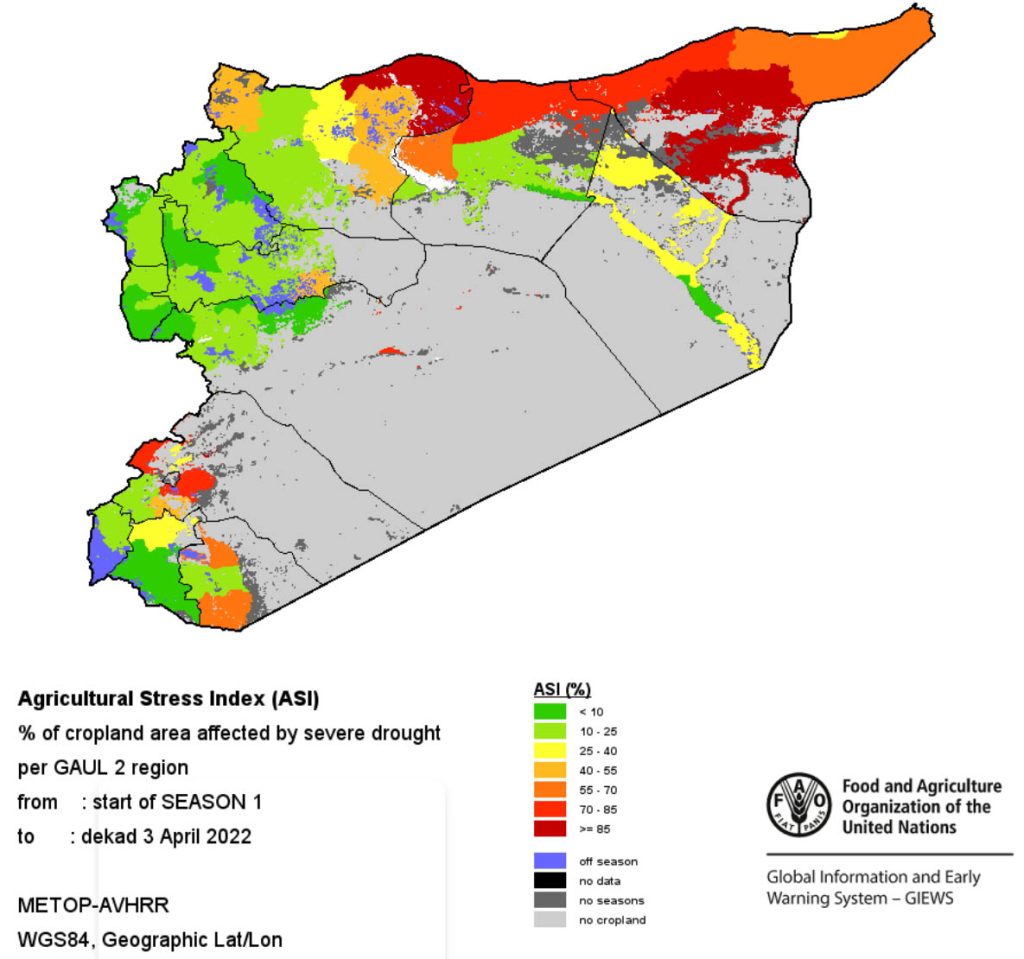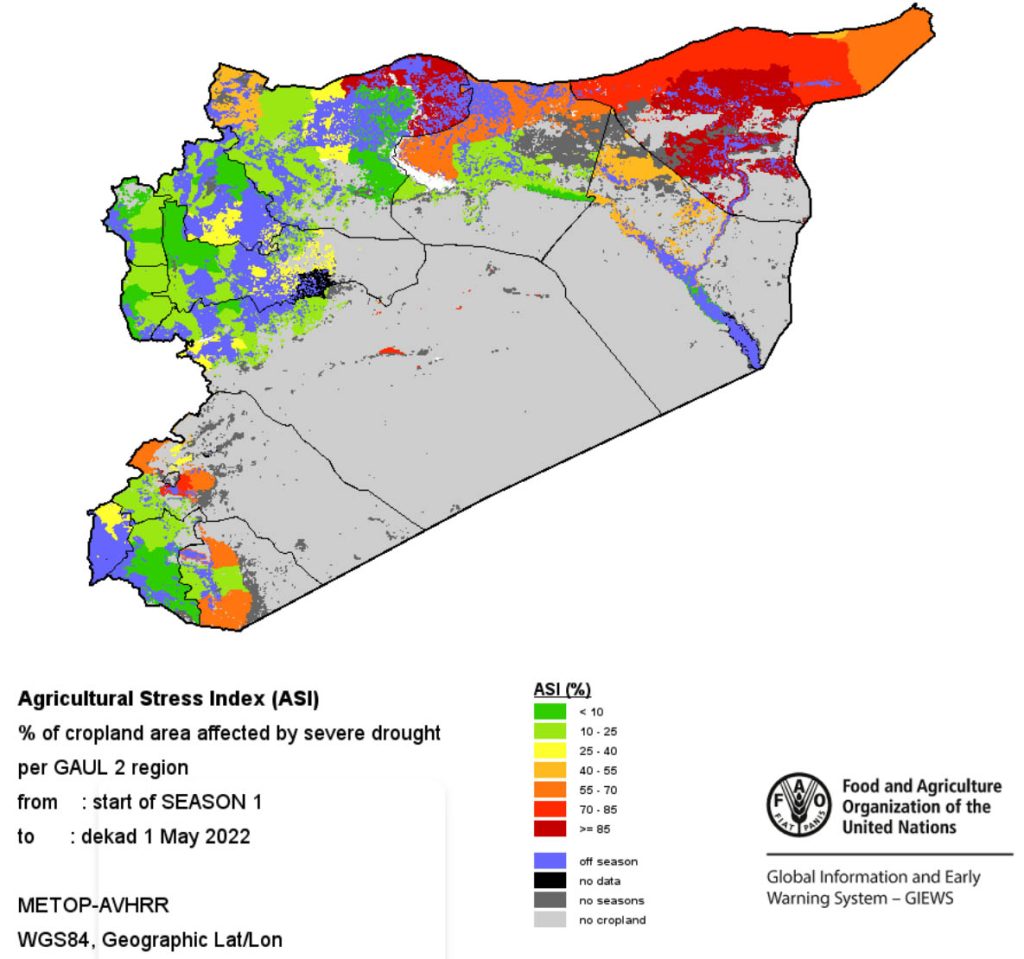Nicholas Lyall, Karam Shaar
This study is available to download here.
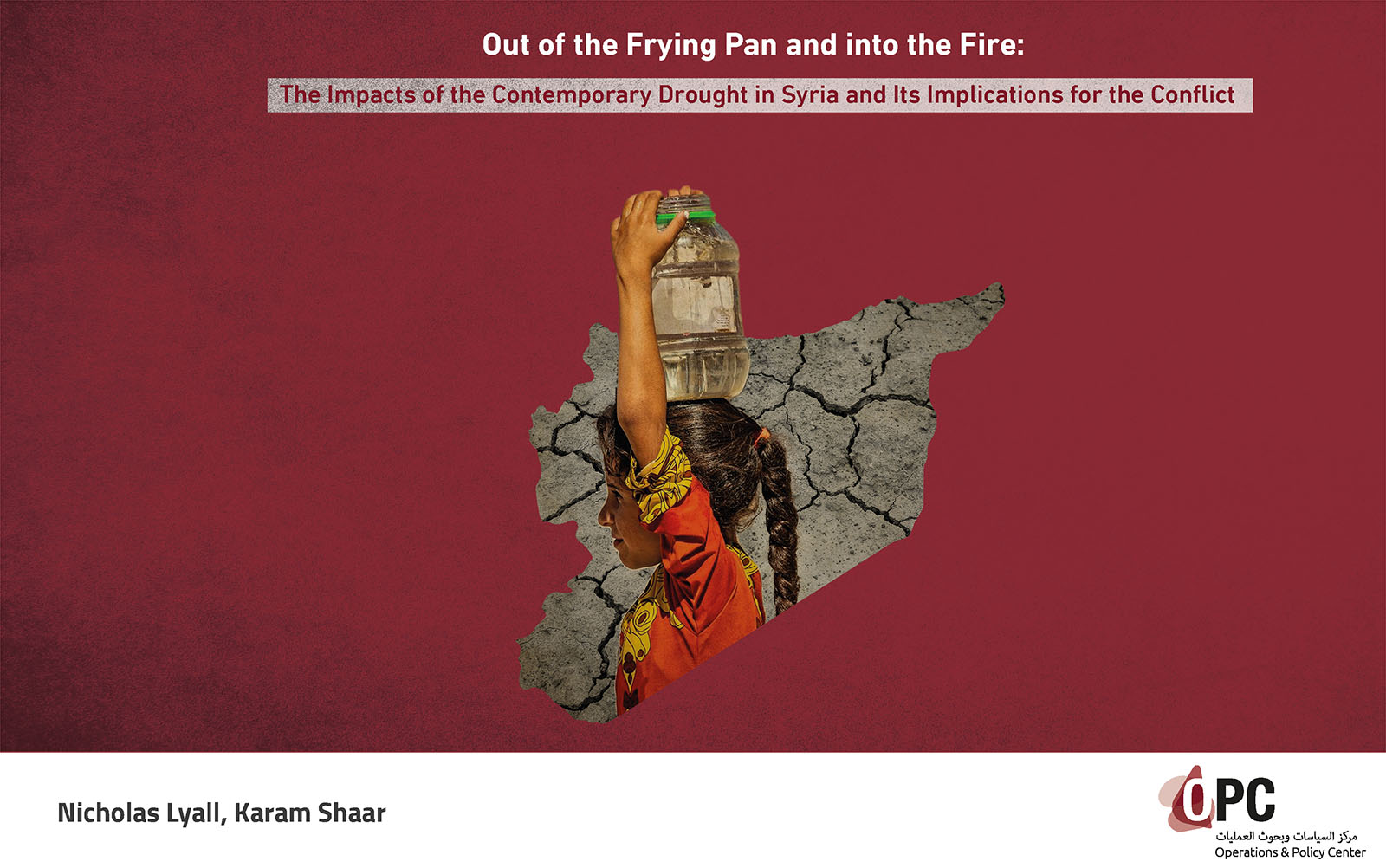
Contents
1. A Looming Crisis?
- 1.1 Assessing the Severity of the Drought
- 1.2 Can Syria Rely on Irrigation to Make Up for the Rainfall Deficit?
2. Economic Impacts of the Drought
3. Humanitarian Impacts of the Drought
4. Projecting Potential Conflict Impact Scenarios
- 4.1 Rural-Urban Migration Stressing Overstretched Services?
- 4.2 The Inability to Secure Bread Causing Popular Action against the Regime?
- 4.3 AANES Legitimacy and its Strength as a Political Actor
- 4.4 Loss of Agricultural Livelihoods Giving Rise to Crime, Spurring Extremist and Militant Group Activity
5. Conclusion
Executive Summary
Since the latter months of 2020, Syria has yet again fallen into a severe drought. This new drought is occurring in a country whose agricultural capacity has already been decimated by decades of agricultural and water misgovernance, as well as an 11-year war, making it less capable of coping with a drought than at any point in its modern history. We analyse various drought and agricultural stress-related satellite and survey data to examine the agricultural situation. A critical finding is that even though Syria experienced higher than average rainfall across the vast majority of the country this past year (compared to the severely lacking rainfall of the year previous), this had no visible effect on improving the health of crop land. This illustrates that Syria’s crop land might have hit a tipping point due to the long-standing agricultural misgovernance, to such a degree that it is unable, or at least significantly struggling, to bounce back from periods of insufficient rainfall.
We then outline the economic impacts Syria is experiencing and is set to experience as a result: domestic bidding wars for scarce agricultural output; further declining foreign currency reserves in the wake of exports disappearing; food prices skyrocketing; and agricultural labour market activity declining. Next, we discuss the dire humanitarian catastrophe that this drought is engendering and exacerbating – already critically high food prices increasing further due to a decreased food supply which cannot be supplemented by imports due to insufficient foreign currency reserves and significantly declining foreign aid. One alarming finding of the report is that Syria would need to spend 16-18% of its 2022 budget just to fill the wheat deficit it is currently facing. Syria has virtually no foreign currency; reserves attempting to import this quantity of wheat would be a critical stressor on the country’s already reeling economy.
Finally, we examine the likelihood that some of the potential effects of the drought will in turn affect the nature of the conflict. We argue that there is unlikely to be much rural-urban migration or anti-regime protests, and little chance that the Autonomous Administration of North and East Syria (AANES) will gain increased strength as a result of being the prime bread-producing region. However, after conducting an original collation and analysis of data regarding the effect of the current drought on the sustainability of agricultural livelihoods in Syria, we find that an immense number of agricultural workers are set to become disenfranchised as a result of the drought. For instance, around three-quarters of resident communities and around one-quarter of IDP communities in AA territory reported agriculture as a source of livelihoods. We then survey the nature of current militant operations and violence in the country, concluding that these operations might absorb a significant number of these disenfranchised workers, thus causing tangible changes in the intensity of the violence and criminal activity.
1.A Looming Crisis?
1.1 Assessing the Severity of the Drought
The toll of the Syrian War on the nation’s agriculture has been devastating. The average annual amount of wheat production between 2006 and 2010 was 3.7 million (metric) tonnes,1 but this declined following the uprising to 2.7 million tonnes between 2011 and 2015, and then to just 1.8 million tonnes between 2015 and 2019.2 The latest nationwide statistics for livestock levels are from 2018, by which point both cattle and sheep numbers were down by 40%, goat numbers were down 29%, and poultry numbers were down by 55%, all relative to 2010.3
Barley production—less reliant on water than wheat—did increase, from an average annual production of 0.77 million tonnes during 2006–2010 to 0.78 million tonnes during 2011–2015, then to 0.97 million tonnes during 2015–2019.4 But it’s safe to argue that aside from a few anomalies the agricultural sector has been heavily affected by the war. However, while data from the Government of Syria shows that agricultural GDP had already declined 41% by 2015,5 agriculture’s share of Syria’s GDP has risen, from 14% in 2010 to 24% as of 2019.6 We can therefore conclude that while the agriculture sector has been decimated by the war, other economic sectors have been affected far more.
Despite the recent low level of activity in the agriculture sector, the 21 May 2021 statement by Syrian Agriculture and Agrarian Reform Minister Mohammed Hassan Qatana that Syria is in the midst of an unprecedented drought becomes even more salient and foreboding. According to Qatana,7
“Syria has not seen such a drought in years. In previous years, drought was witnessed in one or two provinces only, while this year, all provinces have been affected, which severely impacted agriculture. Winter crops, namely wheat and barley, whose production is strategic, were very much affected, especially in rain-fed areas.”
In his statement, Qatana also asserted that precipitation rates over the preceding year decreased by 50-70% depending on the province. Because of this, 80% of Syria’s rain-fed wheat fields—usually half of the country’s total wheat fields—were not planted due to the lack of rainfall. This left 40% of Syria’s total wheat fields lying fallow.
The severity of the situation painted by Qatana was supported by alarming statistics released by the UN Food and Agriculture Organization (FAO). First, FAO estimated that barley production for 2021 was only 268,000 tonnes—just 10% of the 2019 and 2020 harvests. Second, the FAO recently estimated that only 1.05 million tonnes of wheat were harvested in 2021. This represents the lowest wheat harvest in nearly half a century, a 63% reduction from the 2020 harvest 8 of 2.8 million tonnes, and only 25% of the pre-War (2002–2011) average of 4.1 million tonnes.9 It should be noted that the Syrian regime, which cannot access most of the areas where wheat is planted, estimated nationwide wheat production for 2021 at 1.9 million tonnes,10 but even this estimate is drastically lower than the 2020 harvest, let alone pre-War harvests.
The International Rescue Committee stated that the drought in 2021 is the worst Syria has seen in seven decades.11 In April 2021, an assertion by the European Commission was less dramatic but still severe, describing the current drought as one of the worst Syria has suffered in the past 25 years.12 A statement in August 2021 by the head of the Union of Agricultural Specialists in the Autonomous Administration of Al-Raqqa likewise supports the overall grim picture, warning that northeast Syria, which is out of the Damascus government’s control, is facing “real catastrophe” due to drought.13
The effects of this missed wet season were immediately seen, and continue to be seen, with reduced or missing cereals biomass (the overwhelmingly dominant agricultural product in the northeast)14 evident across northeastern Syria, particularly in the Al-Hasakah governorate (the key wheat-producing region of the country).15Indeed, UN experts have estimated that at least 50% of Al-Hasakah’s planted acreage could be wiped out as a result of the sparse rainfall.16 As the northeast’s economy is dependent on agriculture, the gravity of this loss becomes especially apparent.17
However, it is not just cereals biomass that is disappearing. The Normalized Difference Vegetation Index (NDVI) measures ground cover “greenness”—vegetation health and density. Positive values indicate healthy vegetation levels, As shown in the NDVI measurements, the northeast is suffering significantly negative vegetation health, as is much of the northwest, also a key agricultural region; melon and watermelon, fruit trees (including pistachio and olives), early vegetables, barley, wheat, corn, and sugar beet are all produced in this territory.18
Figure 1 – Normalized Difference Vegetation Index (May 2019-2022) relative to long-term average
An even more specific data measurement is the UN Food and Agriculture Organisation’s Agricultural Stress Index (ASI), which focuses on the water stress (drought) being suffered by cropped land in particular.19 As shown below by ASI charts for the last ten days (dekad) of April and the first ten days of May—the immediate lead-in to the beginning of the harvest season in Syria for barley (mid-May until July) and wheat (June until August)—the vast majority of the northeast was characterised by land plots in which 65% or more of the land was dead or dying. Clearly, this means that the wheat and barley harvest for last year was far lower than average.
As shown by the ASI data for the same period in 2022, the available crop land for harvest this year was just as bad, if not worse, than 2021. In other words, Syria is set to experience two vastly insufficient harvests.
Figure 2 – Agricultural Stress Index (dekad 3 of April and dekad 1 of May 2021)
1.2 Can Syria Rely on Irrigation to Make Up for the Rainfall Deficit?
While the nation is clearly in the midst of a drought, putting rain-fed crops in jeopardy, could Syria’s irrigated crops—which draw the vast majority of their water from the Euphrates that flows down into the country from Turkey—provide Syria an agricultural lifeline of sorts? This does not appear to be an option:20, 17
Figure 3 – Share of cultivable land that is irrigated (by governorate)
- According to the latest data, only 23.25% of Syria’s planted land is irrigated; the rest is rain-fed.21 Furthermore, the ongoing fuel crisis in the country means that there is a decreasing capacity to run wells using diesel fuel, meaning irrigated lands themselves are also decreasing.22 This is supported by data from the Bureau of Statistics—30.5% of planted land was irrigated in 2011, but just 23.25% in 2019.23
- Turkey has also suffered from several poor rainfall seasons, meaning the amount of water flowing down through the Euphrates has lessened.24 This decline accelerated rapidly from early 2021.25
- Continued dam investment by Turkey along the Euphrates—Turkey’s three largest dams now sit along this river—means that the amount of water northern Syria can access from the Euphrates is progressively decreasing;26 these dams are using more and more water due to Turkey’s rapidly increasing reliance on them for energy production. By the time Euphrates water reaches Syria, it has passed through five artificial barriers, typically hydroelectric dams, in Turkey.27
But even aside from depleted Euphrates water levels, Syria’s water distribution infrastructure in the northeast is being undermined by Turkey’s control of the Syrian territory it gained during Operation Peace Spring. The operation of the Alouk water pumping station—which is within this territory, and which is imperative for water use across Al-Hasakah—has been repeatedly cut off by Turkey and the Syrian National Army since they gained control in late 2019, meaning that what little water is left in the northeast is not being distributed across the region properly, leading to minimal potable water accessibility.30, 31 Such actions by Turkey are unlikely to change soon, due to the hostility between Turkey and the AANES.
The map of Syria’s major water infrastructure, included below, illustrates the extent of territory that will be acutely vulnerable if these dams and water pumping stations become compromised or lose operational capacity. The inclusion of territorial control indicators on the map highlights dynamics like the severity of the challenge being faced by the AANES should these pieces of infrastructure become compromised.
Figure 4: Water Infrastructure in Syria
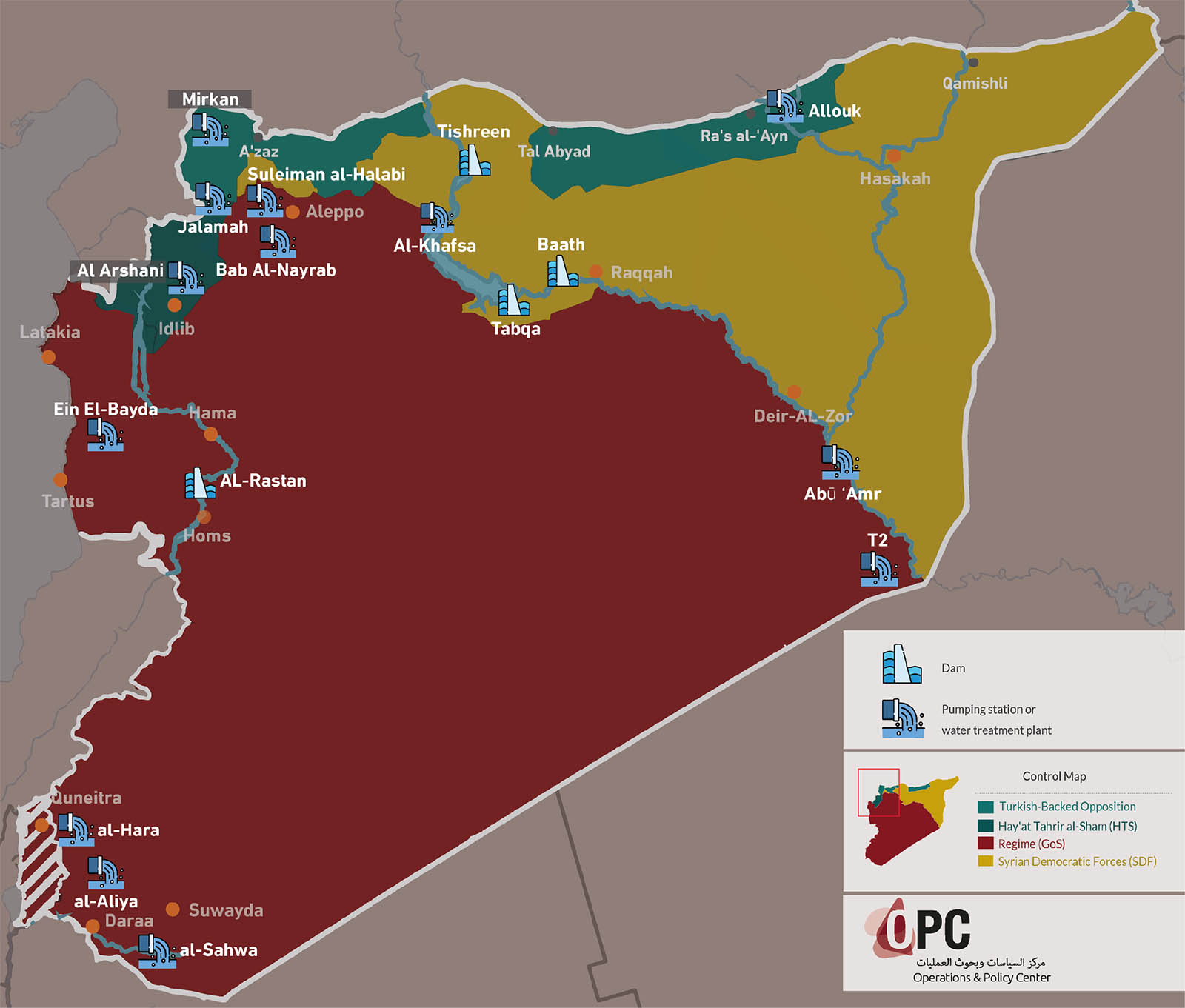
Data sources: Google Maps and a review of relevant literature
The form of water governance from Turkey is exacerbating the decades of agricultural misgovernance under the Assads. A succession of poorly-planned agricultural development schemes, or the lack of any planning at all, saw groundwater reserves wantonly overused and depleted; extensive overgrazing caused desertification.32 The long history of multifaceted misgovernance plus Turkey’s restriction of the Euphrates seems to indicate the tipping point has been reached; Syria’s agriculture has lost its resilience to water scarcity, and droughts like we are now seeing pose a far greater danger of agricultural collapse, as extended droughts will further drain already depleted groundwater reserves.33
This declining or lost resilience may be coming into focus if we compare recent rainfall data with ASI data for Syria. Syria has experienced higher than average (sometimes vastly higher than average) rainfall in all governorates except Damascus and Rural Damascus thus far in 2022.34 However, if we compare the ASI data for the latter months of this year’s wet season to the previous year’s,35 we see that the picture is just as bad, thus pointing to no agricultural relief for the country in 2022 36 (see Figure 2). Accordingly, what impacts are we seeing from this catalyst of the most recent drought and the subsequent agricultural destabilization it has caused thus far?
2. Economic Impacts of the Drought
2.1 Procurement in Light of Bidding Wars
The ongoing drought has caused a drastic decrease in cereals biomass in the country. Wheat, the nation’s most important crop, has been hit particularly hard; it was estimated that the drought would leave Syria 1.5–1.7 million tonnes short of its domestic wheat needs last year.37 Given the comparably alarming ASI data for 2022, a similar shortfall could be expected this year.
The first effect of this wheat shortage is a bidding war for the remaining wheat, between the Damascus regime, the Syrian Salvation Government (SSG) in Idlib, the Syrian Interim Government (SIG) in north and northwest Syria, and the Autonomous Administration (AANES) in the northeast. In response to Damascus raising its purchase offer for wheat in the early summer of 2021, the SIG increased its offer to $325/tonne on 2 June 2021; the SSG then raised its offer to $330/tonne on 5 June.38, 39 All of these were trying to compete with the AANES, whose offering price of $350/tonne made it the most competitive during the 2021 harvest.40
The water shortage is causing a similar bidding war for cotton between the AANES and the regime. In May 2021, the regime doubled its 2020 cotton purchasing offer to a new high of 1.5 million SYP (about 1200 USD) per tonne, which the AANES then beat in August 2021 when it raised its offer to 1.95 million SYP (about 1550 USD) per tonne (a 491% increase from the AANES’s 2020 offer).41 Another round of bidding has just started for the 2022 harvest.
2.2 Exports
Before the War, agriculture and oil were the two industries dominating Syrian exports.18 Syrian oil exports fell significantly as a result of sanctions and subsequent war, allowing agriculture to emerge as the key national export,42 as shown in the graph below.
Figure 5 – Syria’s export profile (2019)

Source: Observatory of Economic Complexity
Note: Merchandise trade data for Syria has serious coverage issues due to smuggling and other reasons related to the conflict.
With the effects of the current drought building, and the resulting decline of Syrian agriculture becoming increasingly apparent, this last major lifeline of Syrian exports—and therefore foreign currency—is disappearing. To put this in perspective, in 2015 Syria had already depleted its foreign currency reserves to only $1 billion.43 Since the beginning of the conflict, state expenses in US dollars continued to exceed revenues, which has been reflected in the steep depreciation of the Syrian pound.
2.3 Livestock
In addition to effects on cereals production and pricing, the drought will also bring heavy impacts to the livestock industry. A common outcome of droughts is that farmers kill off livestock because they cannot feed them —this happened in Syria during the pre-2011 drought.44 In AANES territory, farmers are already beginning to give up on livestock farming; we are also currently seeing livestock culling and selloffs due to declining pasture land and the unavailability of feed due to the drought impacting fodder crops.45 As a result, after an initial short-lived surge in meat supply (and thus price decreases) due to the culled animals, livestock and meat prices will rise due to the decreased supply. Because Syria’s livestock supply was already low,46, 18 supply will dwindle to minimal levels, and prices will increase at a faster pace.
2.4 Livelihoods
Before the war, the agricultural sector provided 14% of Syria’s total jobs, and the food processing sector—directly reliant on agriculture—provided another 16%.47 Of the remaining jobs in the country, 10% are now in agriculture (around 517,000 jobs).48, 49 UN estimates state that the pre-2011 drought in Syria caused 75% of the nation’s farms to fail and 85% of livestock to die;50 the amount of livelihoods set to be destroyed in the wake of the current, seemingly more severe, drought is vast. Crop cultivation and agricultural wage labour is already declining in AANES territory following the onset of the current drought.51
3. Humanitarian Impacts of the Drought
Bread is the overwhelming staple of the Syrian diet; as such, sparse wheat supplies represent a genuine threat to the food security of Syrians. Currently, around 60% of the nation’s wheat is produced in the territory primarily governed by the AANES; approximately 70% of the overall wheat production occurs in territories outside of the Damascus regime’s control.37
In addition to currently offering more favorable prices for wheat compared with those in most of the rest of the country, the AANES has also banned the sale of wheat produced in its territory to anywhere outside.52, 37 Therefore, the rest of the country has not only less wheat being produced overall, but is also largely blocked from 60% of the supply that is being produced. The vast majority of regime-held Syria will face an acute wheat shortage, prompting severe bread supply cuts and further price spikes on top of already drastic bread price inflation over the last several years—the regime has raised the price of bread by 567% from 2011 to 2020.53
The regime’s already negligible foreign currency reserves are insufficient to pay for increased wheat imports. If the regime were to import the 1.5–1.7 million tonne gap at global prices as of 21 April 2022,54 they would pay $600–680 million; that’s about 17% of Syria’s entire 2022 budget of $3.7 billion.55 In the context of Syria’s pre-existing economic crisis, exacerbated by the current Lebanese economic crisis, recent US Caesar Act sanctions, and Covid-19, the necessity to obtain more foreign currency will be another economic stressor on an already reeling economy. Russia agreed to a deal in 2021, where it would fill Syria’s wheat deficit of 1.5 million tonnes. However, as of this writing, Russia has exported only 350,000 tonnes to Syria,56 and Russia’s supply has now slowed due to decreasing availability of Syrian funds.37
3.1 Will Foreign Aid Save the Day?
Given the unlikelihood of the market filling Syria’s wheat deficit, will food aid be an option to fill the gap? The signs aren’t promising, as humanitarian funding to the country is declining. In 2020, $2.7 billion of the $3.82 billion (71%) in humanitarian funding requested by the UN for Syria was delivered.57 But in 2021, only $2.3 billion of the $4.2 billion (55%) requested for the year was delivered.58
While public spending policies around the world increased in the first year following the outbreak of Covid-19, as part of expansionary fiscal policies to try and mitigate the economic freefall, public spending is now contracting as governments adapt to the new normal. Accordingly, aid budgets have been the first to feel the cuts, and humanitarian assistance to Syria is already emerging as a key victim. For instance, in April 2022 the World Food Program (WFP) made its fourth consecutive cut in two years to its aid contributions to Syria, due to declining availability of aid resources.59 The issue becomes even more dire when considering that such aid cuts are occurring at the exact time that aid needs to be increased due to Syria’s rapidly declining ability to feed itself as a result of the drought.
Another critical dynamic to consider is that the current afflictions in terms of food supply are made worse by the drastically decreased coping capacity of the population since 2011 because of the ongoing conflict. To highlight this, a WFP report on food security released in July 2021 stated that 12.4 million Syrians (more than 60% of the population, and more than double the number reported in 2018) were already food insecure, and 1.3 million were severely food insecure. Furthermore, the report projected food insecurity to increase significantly over the several months after publication, due to “the ongoing economic collapse, a reduced cereal harvest, [and] increasing difficulties in securing supplies of general items.”60, 37
The pre-existing state of food insecurity that was extant before the current drought is also illustrated by the fact that the nationwide average price of a standard reference food basket increased month after month between August 2019 and May 2021, and then has increased ceaselessly again since June 2021.61 From mid-2020 to mid-2021 alone, the national average of food prices increased by more than 200%.37 This points to the rapidly increasing trajectory of food insecurity, a critical dynamic also highlighted by the fact that there was a 61% increase in the number of households who reported poor or borderline food consumption from May 2020 to May 2021.62
4. Projecting Potential Conflict Impact Scenarios
4.1 Rural-Urban Migration Stressing Overstretched Services?
The fact that most Syrian urban centers are currently in a state of decrepitude following the war is an important one; such disarray would likely discourage rural Syrians with agricultural backgrounds from relocating to cities, a deterrent that was less present during the drought in the few years preceding 2011. In addition, the literature on the migration-conflict connection in the Syrian conflict largely finds, with some disputation, that the pre-2011 drought did accelerate rural-urban migration, but also finds it very difficult to prove a connection between said migration and the outbreak of the 2011 protests and subsequent war.63 Accordingly, when examining the effects of the present drought on the trajectory of the current conflict in Syria, it is more prudent to look into factors other than the rural-urban migration dynamic.
4.2 The Inability to Secure Bread Causing Popular Action against the Regime?
Citizens in regime-controlled areas, at times, queue for up to six hours at bakeries to buy poor quality, rationed bread at unaffordable prices.64, 37, 65 Exacerbating this has been the existence of privileged access to subsidized bread combined with regime-aligned shabiha thugs seizing bread from bakeries.66 Accessibility to affordable bread is considered by many Syrians to be a red line,67 so if the bread crisis and inequitable access continue to deteriorate then protests may well develop. However, protests are unlikely to alter the path of the conflict, given the brutal response protesters are likely to face if their protests evolve from criticizing the civil elements of the government to criticizing the inner circle of the regime or its head, Bashar al-Assad. Accordingly, potential future protesters are unlikely to direct their grievances at the regime itself, instead raising their voices against entities like government officials, which will mean little to no impact on the course of the conflict.
4.3 AANES Legitimacy and its Strength as a Political Actor
Considering that the average Syrian consumes 180 kilograms (396 pounds) of wheat per year,68 the AANES needs roughly 576,000 tonnes of wheat this year to feed its population of around 3.2 million.69 Given that AANES territory was expected to produce only around 630,000 tonnes of wheat in the 2021 harvest—70 and that figure is unlikely to have increased in 2022 with the disturbing ASI data—it is not unreasonable to assume that the AANES will end up with only marginally enough to feed its own population. Therefore, it is not certain that the AANES will have much surplus to bargain with the regime once it accounts for the wheat needs of people living under its control. Furthermore, the AANES has allocated $100 million in their 2022 budget for buying wheat flour—a sign that they anticipate becoming a net importer of wheat.71
4.4 Loss of Agricultural Livelihoods Giving Rise to Crime, Spurring Extremist and Militant Group Activity
It has been well documented that the pre-2011 drought drove many rural Syrians to join militant groups once their agricultural livelihoods were lost.72 While precise numbers of such recruitment are hard to come by, we do know that around 800,000 Syrians “lost their livelihoods” as a result of the pre-2011 drought.73 But how many Syrians still derive their livelihoods from agriculture, and therefore might be at new risk of recruitment, or alternatively at risk of turning to crime?
We can begin to establish this new figure by collating data collected by REACH. REACH obtained data each month from 1210–1260 communities (varies by month) across “northeast Syria”—those areas of Al-Hasakah, Deir ez-Zor, Ar Raqqah, and Aleppo governorates in current AANES territory. Data was also obtained from 350 communities across “northwest Syria” (areas of Idlib and Aleppo governorates held by HTS, and of Hama governorate held by a variety of opposition factions).74
One topic within this data collection was whether internally-displaced (IDP) and resident communities relied on food crop production, cash crop production, livestock products, or sale of livestock (a form of agriculture) as the most common source of livelihoods. Such rich data do not exist for regime-held territory or areas under direct Turkish control.
For “northeast Syria,” we aggregated monthly data on this question to ascertain that in 2021 64–77% of resident communities and 27–32% of IDP communities reported some form of agriculture as the most common livelihood source within the community.75 Given that the population of AANES territory is currently at a minimum but is almost certainly higher than 3.2 million,76 these figures point to an immense quantity of population being vulnerable to recruitment.
Even a relatively modest percentage of the above figures transitioning into militant activity would cause a tangible impact on the nature of the conflict. Similarly, even a limited portion turning to crime will add serious pressures to socio-economic stability. It could be organized crime—e.g., disenfranchised individuals becoming involved in kidnapping groups or integrating into the exploding Captagon77 narcotics industry and smuggling networks emanating from Syria—or unorganized crime, like mugging and looting. The rise in crime has serious and obvious implications for the entrenchment and proliferation of black-market networks and industries not only in Syria, but across the Levant,78 and poses threats to social cohesion and human security across Syrian communities.
Again, we can establish this likelihood by collating the data collected by REACH about key barriers preventing agricultural livelihoods from being maintained in communities. The data was split between “resident” and “IDP” households within a community, as sometimes a community had only one type of household but not the other.
One of these barrier options was “insufficient water.” By extracting and collating this data from the answers (using a period of 12 months starting from October 2020, when the first wet season in the most recent drought began, so that we start to see the effects of the drought), we can begin to get a picture of the worsening trend of those who are being pushed out of agricultural livelihoods due to the current water crisis. With a widespread absence of alternative livelihoods, these disenfranchised populations will be potentially susceptible to joining criminal or militant groups. So, what proportion of communities listed “insufficient water” as a key barrier preventing them from maintaining agricultural livelihoods, and how did this trend develop over the October 2020–October 2021 period?
The results for Al-Hasakah (overwhelmingly resident households) fluctuated between 20% and 42% for most of the year. The northeast (AANES) portion of Aleppo (overwhelmingly IDP households) rose to a significant rate and remained there for the final few months of the period. In Idlib, in the northwest, both resident and IDP households showed a consistently upward trend over the course of the year. All of these figures point to the potential for a sufficiently high number of disenfranchised agricultural workers to transition into crime or extremism; if they do so, it will cause a tangible change in the status quo of conflict and violence across various parts of the country.
Now that we have outlined the scope of agricultural workers who could become disenfranchised, and that turning to crime is a self-evident likelihood for many of those disenfranchised, it is necessary to determine whether extremist and militant groups in Syria are still sufficiently operational to offer an alternative livelihood for disenfranchised populations. The Syrian job market is even more decrepit than it was pre-2011; disenfranchised Syrians might turn to militant or extremist groups for employment out of desperation, as these groups often have access to black market networks, and may be able to offer better pay than the current traditional Syrian job market. A related question: even if able to offer livelihoods, are these groups sufficiently active that an influx of new recruits could see qualitative changes in the conflict status quo?
By sampling some of the militant and extremist group activity across Al-Hasakah, Aleppo, and Idlib governorates alone, the remainder of this section will consider both questions.
Turkish-backed armed groups have been consistently active against the SDF (Syrian Democratic Forces, US-backed Kurds in AANES) in 2021 along the western part of the Operation Peace Spring territory,79, 80, 81 perpetrating “increased killings, kidnappings, unlawful transfers of people, seizures of land and properties and forcible evictions” against opponents of Turkey’s presence (primarily Kurds and those linked to the AANES).82, 83 Additionally, these Turkish-backed armed groups have also been fighting amongst themselves.84 Therefore, an influx of disenfranchised agricultural workers to these Turkish-backed groups—many of whom are Arab, already marginalized and disquieted by AANES governance—could see an escalation of both this infighting and the abovementioned abuses.
ISIS has also been active in Al-Hasakah in recent months, conducting numerous attacks—85 including explosives attacks and assassinations targeting the SDF, 86, 87 as well as tribal and civic leaders and civilians.88 Notably, ISIS seems to have gained strength in the preceding months, illustrated by its seven-day attack on al-Sina’a Prison in Hasakah city in January 2022—the largest ISIS operation since the fall of the Caliphate in March 2019.89 If ISIS were to absorb more recruits we could potentially expect to see an uptick in attacks overall, including more large-scale operations like al-Sina’a.
Then we have Iran and Hezbollah. Iran has been facilitating the establishment of local Shia militias in Aleppo governorate, and has even recruited Sunnis under the Local Defense Forces, which is associated with the Syrian Arab Army.90 New Iranian recruitment campaigns have targeted the creation and expansion of militias like Ashbal Suleimani91 as well as the Al-Imam Ali Brigade.92 Hezbollah-backed militias have been looting, confiscating property, and harassing returnees in northern Aleppo.93, 94 An assortment of other militias have also, in recent months, increased the rate of looting, thefts, kidnapping, and extortion in eastern Aleppo city.95
HTS remains the dominant group in Idlib, focusing much of its activity on suppressing other armed groups in the governorate.96, 97, 98, 99 But the remaining militant/extremist situation involves, on one hand, potentially unaffiliated groups with unclear links to HTS who have continuously targeted Turkish troops with IEDs and armed vehicle attacks.100 On the other hand are the National Liberation Front (a Turkish-backed alliance of other armed groups)101, 102 and the Turkistan Islamic Party based around Jisr al-Shughour,103, 104 which has a certain level of ties to Turkey. Accordingly, the movement of significant numbers of disenfranchised agricultural workers into militancy in this region could see increases in both HTS vs. militant and Turkish vs. militant violence.
All of the above examples provide just a small representation of the array of Sunni vs. Shia, as well as Turkish- vs. Iran-backed, conflict that is manifesting violently. Any significant influx of disenfranchised agricultural workers into this complex melting pot of militancy could see the situation become increasingly messy and even more violent.
In short, the drought could potentially be a push factor toward a spiking intensity of militancy and violence. But due to the nature of the conflict, where most fighting groups are proxies of foreign powers, control lines are unlikely to change dramatically without direction from these outside players. Activities like crime, sporadic violence, looting, and drug production are likely to increase as the agricultural situation deteriorates, but it is unlikely to be the cause of fundamental changes in the conflict balance in the absence of increased foreign funding and any desire for escalation.
5. Conclusion
Making firm predictions about an intractable conflict like that in Syria is an endeavor that makes fools of most. But such predictions were not the aim of this piece. Instead, the aim was to provide for the first time an analysis that
- clearly lays out the current alarming agricultural data and synthesizes it with the recent history of water misgovernance in Syria, to highlight the likely dire inability of Syria to sustain itself going forward
- outlines the key negative economic impacts of this ominous agricultural situation, ranging from spiraling market prices for agricultural goods to mass livelihood losses
- analyses how Syria is unable to rely on alternative supply chains and aid to adapt to the agricultural decline
- takes all of the above into account to provide preliminary projections on how these dynamics might impact the foreseeable future of the conflict
We believe that the key vector through which the drought and ensuing agricultural decline may affect the conflict status quo is through a potential influx of disenfranchised agricultural workers into criminal, militant, and exremist groups. By combing the data, we were able to establish that agriculture employs the majority of workers in both AANES and opposition/Turkish-held territory in Syria. We were then able to establish from the data that the drought threatens to disenfranchise vast numbers of these agricultural workers in Al-Hasakah governorate, in the opposition-held portion of Idlib governorate, and in the SDF-held portion of Aleppo governorate.
- metric tonne = 1.102 US ton (2,204 pounds to US 2,000 pounds) [↩]
- “GIEWS Country Brief – The Syrian Arab Republic” (archive), PDF, Food and Agriculture Organization of the United Nations (UNFAO), 2021, https://www.fao.org/giews/countrybrief/country/SYR/pdf_archive/SYR_Archive.pdf. [↩]
- “Special Report – FAO/WFP Crop and Food Security Assessment Mission to The Syrian Arab Republic,” PDF, Food and Agriculture Organization of the United Nations (UNFAO), September 5, 2019, https://bit.ly/3tnmG1A, 27–30. [↩]
- UNFAO, “GIEWS Country Brief – The Syrian Arab Republic.” [↩]
- “The Toll of War: The Economic and Social Consequences of the Conflict in Syria,” The World Bank, July 10, 2017, https://bit.ly/WorldBank_Toll-of-War_Syria. [↩]
- “National Accounts,” Syrian Central Bureau of Statistics, http://cbssyr.sy/index-EN.htm. [↩]
- “Minister of Agriculture, Mohamed Hassan Qatana, for Sham FM” (in Arabic), Sham FM Facebook Page, May 21, 2021, https://web.facebook.com/radioshamfm/posts/3912435032143095?_rdc=1&_rdr. [↩]
- “Report Highlights Syria’s Struggling Agricultural Sector,” The Syria Report, December 21, 2021, https://syria-report.com/news/report-highlights-syrias-struggling-agricultural-sector/. [↩]
- The Syria Report, “Report Highlights Syria’s Struggling Agricultural Sector.” [↩]
- “The Area Planted with Wheat is Reducing” (in Arabic), Enab Baladi, March 12, 2022, https://bit.ly/3xdQMpF. [↩]
- “Syria 11 Years On: Hunger, Drought and a Collapsing Economy Threatens Even More Misery for Millions, The IRC Warns,” International Rescue Committee, March 15, 2022, https://bit.ly/SyrAR_11-years-hunger-drought. [↩]
- “GDO Analytical Report: Drought in Syria and Iraq – April 2021,” European Commission – Joint Research Centre, April 23, 2021, https://reliefweb.int/report/iraq/gdo-analytical-report-drought-syria-and-iraq-april-2021. [↩]
- “Autonomous Administration Warns of a ‘Disaster’ Due to Drought in Northeastern Syria” (in Arabic), Enab Baladi, August 9, 2021, https://www.enabbaladi.net/archives/511203. [↩]
- Mustafa Bayram and Yasemin Gök, “The Effects of The War on The Syrian Agricultural Food Industry Potential,” Turkish Journal of Agriculture-Food Science and Technology, 8, no.7 (2020), 1448-1462. [↩]
- “Anomaly Hotspots of Agricultural Production – Syrian Arab Republic,” European Commission – Joint Research Centre, https://mars.jrc.ec.europa.eu/asap/country.php?cntry=238. [↩]
- Suleiman Al-Khalidi, “Syrian Drought Puts Assad’s ‘Year of Wheat’ In Peril,” Reuters, June 21, 2021, https://reut.rs/3zsgCJ4. [↩]
- Enab Baladi, “Autonomous Administration Warns of a ‘Disaster’ Due to Drought in Northeastern Syria.” [↩] [↩]
- Bayram and Gök, “The Effects of The War on The Syrian Agricultural Food Industry Potential.” [↩] [↩] [↩]
- “Earth Observation,” Food and Agriculture Organization of the United Nations (UNFAO), accessed 5 June 2022, https://bit.ly/FAO_3NYwMhf. Essentially, ASI measures current Vegetation Health Index data (i.e., the amount of cropped land that is not dead or dying) at a specific point in time in a specific arable location within a country. The percentage figure provided in an ASI map illustrates how much of the current location (defined as one pixel on the map) has a Vegetation Health Index data value of below 35% (i.e., 65% or more of the crop land in that location is dead or dying), as this value has been identified as a “critical threshold in assessing the extent of drought” by previous research. In other words, in the areas shaded the darkest hue of red in the below maps, more than 85% of the pixels within those areas are suffering dead or dying crop land to an extent of 65% or more. [↩]
- Arnon Karnieli et al., “Was Drought Really the Trigger Behind the Syrian Civil War in 2011?” Water, 11, no.8 (2019), 1564, https://www.mdpi.com/2073-4441/11/8/1564. [↩]
- “Land Use 2015-2019,” Syrian Central Bureau of Statistics. http://cbssyr.sy/index-EN.htm. [↩]
- Suhail al-Ghazi, “The Wheat and Bread Crisis In Syria And Its Impact On The Population,” PDF, ORSAM, July, 2021, https://www.orsam.org.tr/d_hbanaliz/the-wheat-and-bread-crisis-in-syria-and-its-impact-on-the-population.pdf, 7. [↩]
- “Land Use 2011-2015,” Syrian Central Bureau of Statistics. http://cbssyr.sy/index-EN.htm. [↩]
- “Syrian Arab Republic: Euphrates Water Crisis & Drought Outlook, as of 17 June 2021,” UN Office for the Coordination of Humanitarian Affairs (UNOCHA), June 21, 2021, https://bit.ly/UNCHA_Syr-Water-Crisis-17Jun2021. [↩]
- “Briefing Note: Humanitarian Impact of Water Shortages in Northeast Syria (April 2022),” REACH, April 20, 2022, https://reliefweb.int/report/syrian-arab-republic/briefing-note-humanitarian-impact-water-shortages-northeast-syria-april, 1. [↩]
- It should be noted that the rate of Euphrates water supply to Syria has been declining, on average, for several decades (see Dursun Yildiz, “A Natural Diminishing Trend of The Tigris and Euphrates Stream Flows Is Alarming for The Middle East Future,” World Scientific News, 47, no.2(2016), 279-297, 293.). However, Turkey’s dam projects are expediting this decrease. [↩]
- “Briefing Note: Humanitarian Situation Overview in Northeast Syria (June 2021),” REACH, June 24, 2021, https://reliefweb.int/report/syrian-arab-republic/briefing-note-humanitarian-situation-overview-northeast-syria-june-2021. [↩]
- UNOCHA, “Syrian Arab Republic: Euphrates Water Crisis & Drought Outlook, as of 17 June 2021.” [↩]
- REACH, “Briefing Note: Humanitarian Situation Overview in Northeast Syria (June 2021).” [↩] [↩]
- REACH, “Briefing Note: Humanitarian Situation Overview in Northeast Syria (June 2021).” Also, on-the ground sources for the Operations and Policy Center. [↩]
- It should be noted that the AANES has also cut off electricity to the Turkish-held Operation Peace Spring territory in retaliation multiple times. [↩]
- Francesca de Châtel, “The Role of Drought and Climate Change in the Syrian Uprising: Untangling the Triggers of the Revolution,” in Ken Conca and Geoffrey D. Dabelko (Eds), Green Planet Blues—Critical Perspectives on Global Environmental Politics (New York: Routledge, 2019), 286-304. [↩]
- Tobias Ide, “Climate War in The Middle East? Drought, The Syrian Civil War, and the State of Climate-Conflict Research,” Current Climate Change Reports, 4, No.4 (2018), https://bit.ly/3mmkNyx, 347-354. [↩]
- REACH, “Briefing Note: Humanitarian Impact of Water Shortages in Northeast Syria (April 2022),” 1. [↩]
- “Earth Observation – Syrian Arab Republic (Vegetation Indicators),” Food and Agriculture Organization of the United Nations (FAO), https://www.fao.org/giews/earthobservation/country/index.jsp?lang=en&type=21&code=SYR. [↩]
- The European Drought Observatory in March 2022 alerted of a medium to high risk of drought impact on agriculture, compared to no areas being at risk in March 2021. See: REACH, “Briefing Note: Humanitarian Impact of Water Shortages in Northeast Syria (April 2022),” 1. [↩]
- Al-Khalidi, “Syrian Drought Puts Assad’s ‘Year of Wheat’ In Peril.” [↩] [↩] [↩] [↩] [↩] [↩] [↩]
- al-Ghazi, “The Wheat and Bread Crisis in Syria and its Impact on the Population,” 5. [↩]
- “Four Prices for Wheat in Syria: ‘Autonomous Administration’ Determined the Highest Among Them” (in Arabic), Enab Baladi, June 6, 2021, https://www.enabbaladi.net/archives/486667. [↩]
- Enab Baladi, “Four Prices for Wheat in Syria.” The exchange rate used to convert the SYP price quoted in this Enab Baladi source can be derived from Karam Shaar, “Hourly Black Market Exchange Rates And Gold Prices In Syria By City,” Karam Shaar: Making Sense of Syria’s Economy, https://www.karamshaar.com/exchange-rates. [↩]
- “AANES Hikes Cotton Procurement Price,” The Syria Report, September 1, 2021, https://bit.ly/AANES_cotton-prices. [↩]
- Hussam Al Bakeer, “Report About the Agricultural Situation in Syria” (in Arabic), Heinrich-Böll-Stiftung, June 2018, https://www.boell-thueringen.de/de/2018/06/07/tqryr-n-lwd-lzry-fy-swry. [↩]
- The World Bank, “The Toll of War: The Economic and Social Consequences of the Conflict in Syria,” vii. [↩]
- “Syrian Arab Republic Situation Report – September 2016,” PDF, Food and Agriculture Organization of the United
Nations (FAO), September 2016, https://bit.ly/FAO_Syr-Situation-Sept2016. [↩]
- REACH, “Briefing Note: Humanitarian Impact of Water Shortages in Northeast Syria (April 2022),” 3. [↩]
- Elaisha Stokes, “The Drought That Preceded Syria’s Civil War Was Likely the Worst in 900 Years,” Vice News, March 3, 2016, https://www.vice.com/en/article/3kw77v/the-drought-that-preceded-syrias-civil-war-was-likely-the-worst-in-900-years. [↩]
- Syrian Bureau of Statistics, 2010. Labour Statistics, Annual Statistical Abstract, www.cbssyr.sy/. [↩]
- “Employment in Agriculture (% Of Total Employment) (Modeled ILO Estimate),” The World Bank, https://bit.ly/WBank_Syr-Agri-Employment. [↩]
- “Labor Force, Total—Syrian Arab Republic,” The World Bank, https://bit.ly/WBank_Syr_Labour. [↩]
- Stokes, “The Drought That Preceded Syria’s Civil War Was Likely the Worst in 900 Years.” [↩]
- “Briefing Note: Humanitarian Impact of Water Shortages in Northeast Syria (April 2022),” 3. [↩]
- Athr Press, “Wheat Supply Fluctuates Due to Drought and SDF Interference,” The Syrian Observer, June 9, 2021, https://syrianobserver.com/features/66738/wheat-supply-fluctuates-due-to-drought-and-sdf-interference.html. [↩]
- al-Ghazi, “The Wheat and Bread Crisis in Syria and Its Impact on The Population,” 9. [↩]
- “Global Price of Wheat,” Federal Reserve Bank of St. Louis, December 15, 2021,
https://bit.ly/FedStLou_GlobalWheatPrices. [↩]
- “Visualizing Syria’s 2020, 2021, and 2022 Budgets,” Operations and Policy Center, January 17, 2022, https://opc.center/visualizing-syrias-2021-budget/. [↩]
- Polina Devitt, “Russia Plans to Supply Up to 1 Million Tons of Wheat to Syria in 2021,” Nasdaq, May 28, 2021, https://bit.ly/3xb7ru0. [↩]
- “Syrian Arab Republic 2020,” Financial Tracking Service – UN Office for the Coordination of Humanitarian Affairs (UNOCHA), https://fts.unocha.org/countries/218/flows/2020. [↩]
- “Syrian Arab Republic 2021,” Financial Tracking Service – UN Office for the Coordination of Humanitarian Affairs (UNOCHA), https://fts.unocha.org/countries/218/flows/2021. [↩]
- “World Food Programme Reduces the Contents of Food Baskets in Northern Syria” (in Arabic), Enab Baladi, August 4, 2022, https://www.enabbaladi.net/archives/563769. [↩]
- “Hunger Hotspots: FAO-WFP Early Warnings on Acute Food Insecurity (August–November 2021 Outlook),” World Food Program, July 30, 2021, https://bit.ly/WFP_Hunger-Hotspots_Aug-Nov2021. [↩]
- “WFP Syria Situation Report #5 May 2021,” World Food Program, May 2021,
https://bit.ly/WFP_Syr_SitRep05_May2021. [↩]
- World Food Program, “WFP Syria Situation Report #5 May 2021.” [↩]
- Tobias Ide, “Climate War in the Middle East?” [↩]
- “Poor Quality and Long Queues… The Bread Crisis Exists in Syria Despite Government Promises” (in Arabic), Enab Baladi, March 5, 2021, https://www.enabbaladi.net/archives/463364#ixzz6viHnfH9K. [↩]
- al-Ghazi, “The Wheat and Bread Crisis in Syria and its Impact on the Population,” 9. [↩]
- “US-Backed YPG Seizes Bakeries, Prompts Bread Crisis in Northern Syria,” Daily Sabah, March 14, 2021, https://bit.ly/3tlJAGQ. [↩]
- al-Ghazi, “The Wheat and Bread Crisis in Syria and its Impact on the Population,” 10. [↩]
- “GIEWS Update 17 December 2020 – Syrian Arab Republic National Cereal Balance [2020/21 Marketing Year (July/June)],” PDF, Food and Agriculture Organization of the United Nations (FAO), December 17, 2021, https://www.fao.org/3/CB2500EN/CB2500EN.pdf. [↩]
- Sinan Hatahet, “The Political Economy of the Autonomous Administration of North and East Syria,” European University Institute, November 29, 2019, https://cadmus.eui.eu/bitstream/handle/1814/65364/MED_WPCS_2019_16.pdf, 2. It should be noted that exact figures are hard to come by, and this figure of 3.2 million is likely less than reality. [↩]
- This figure is obtained by starting from the 1.05 million tonne forecast for 2021 by the FAO, then multiplying it by 60%, since AANES territory produces around 60% of Syria’s wheat. [↩]
- “Autonomous Administration: $80 Million Budget for Next Year’s Projects,” North Press Agency, November 16, 2021, https://npasyria.com/86668/. [↩]
- Peter Schwartzstein, “Climate Change and Water Woes Drove ISIS Recruiting in Iraq,” National Geographic News, November 14, 2017. https://www.nationalgeographic.com/science/article/climate-change-drought-drove-isis-terrorist-recruiting-iraq. [↩]
- IRIN News, “Drought Blamed for Food Scarcity,” The New Humanitarian, February 22, 2009, https://bit.ly/NHum_22Feb2009. [↩]
- “Humanitarian Situation Overview of Syria,” REACH, accessed June 2, 2022, https://reach-info.org/syr/hsos/. [↩]
- Note that the calculations presented here are not weighted by the population of each community, as such data was not available for a recent date. [↩]
- Hatahet, “The Political Economy of the Autonomous Administration of North and East Syria,” 2. This population estimate doesn’t include the AANES-held territory of Tal Rifaat in Aleppo, for example. [↩]
- An illegal, cheaply made amphetamine [↩]
- The Levant is a term used historically for the area along the eastern shore of the Mediterranean Sea: Israel, Lebanon, Jordan, Syria, and certain other adjacent areas. [↩]
- “Humanitarian Situation Overview in Syria (HSOS): Northeast Syria, November 2020,” REACH, December 22, 2020, https://bit.ly/REACH_Humanitarian-Overview-NE-Syria_Nov2020, 1. [↩]
- “Report of the Independent International Commission of Inquiry on the Syrian Arab Republic,” United Nations Human Rights Council (UNHCR), August 14, 2020, https://digitallibrary.un.org/record/3880804?ln=en, 2. [↩]
- “Lead Inspector General for Operation Inherent Resolve I Quarterly Report to [US] Congress (July 1, 2020–September 30, 2020),” US Department of Defense, October 30, 2020, https://bit.ly/USDoD_IGReport_InherentResolve_Jul-Sep2020, 63. [↩]
- “Syria: Violations and Abuses Rife in Areas Under Turkish-Affiliated Armed Groups – Bachelet,” United Nations Office of the High Commissioner for Human Rights (UNOHCHR), September 18, 2020, https://bit.ly/UNHCR_Syr-Abuses_Bachelet. [↩]
- “Report of the Independent International Commission of Inquiry on the Syrian Arab Republic,” United Nations Human Rights Council (UNHRC), August 14, 2020 (published September 15, 2020), https://bit.ly/UNHCR_IICI-SyrArabRep_14Aug2020, 12. [↩]
- UNOHCHR, “Syria: Violations and Abuses Rife in Areas Under Turkish-Affiliated Armed Groups – Bachelet.” [↩]
- Aaron Zelin and Michael Knights, “The Islamic State’s Resurgence in the COVID Era?” The Washington Institute for Near East Policy, May 29, 2020, https://bit.ly/WINEP_ISIS-resurge-in-COVID. [↩]
- From Defeat to Renewal in Iraq and Syria,” The Washington Institute for Near East Policy, May 29, 2020, https://www.washingtoninstitute.org/policy-analysis/islamic-states-resurgence-covid-era-defeat-renewal-iraq-and-syria. [↩]
- 97-“Implementation of Security Council Resolutions 2139 (2014), 2165 (2014), 2191 (2014), 2258 (2015), 2332 (2016), 2393 (2017), 2401 (2018), 2449 (2018), 2504 (2020), and 2533 (2020) – Report of the Secretary-General,” United Nations Security Council, April 22, 2021, https://documents-dds-ny.un.org/doc/UNDOC/GEN/N21/091/87/PDF/N2109187.pdf?OpenElement, 3. [↩]
- Baraa Khurfan et al., “Indicators of Security Stability in Syria and Refugee Return: An Evaluation of Select Cases,” OMRAN Center for Strategic Studies, December 17, 2020, https://bit.ly/OMRAN_Syria-Security-Stability-Refugee-Return, 19. [↩]
- “Operation Inherent Resolve: Lead Inspector General Report to the United States Congress,” United States Department of Defense, May 4, 2021, https://bit.ly/USDoD_Operation-Inherent_Resolve, 16, 62. [↩]
- Ido Levy, “Battle for al-Sina’a Prison: The Enduring Islamic State Threat in Syria,” The Washington Institute for Near East Policy, January 31, 2022, https://bit.ly/WINES_Battle-for-Sinaa_Prison. [↩]
- Navvar Saban, “Factbox: Iranian Influence and Presence in Syria,” Atlantic Council, November 5, 2020, https://bit.ly/3aNDcSi. [↩]
- “Iran Recruits In Aleppo, and Entices the Youth by Settling Their Affairs with the Regime” (in Arabic), Al-Arabiya, March 22, 2021, https://bit.ly/Al-Arabiya_Iran-Recruits-in-Aleppo_AR. [↩]
- “Nobbol and Zahra’a Militias Control Northern Aleppo – Looking for Funding Sources” (in Arabic), Al-Quds Al-Arabi, December 28, 2020, https://bit.ly/Nobbol-Zahara-Militia-Control-N_Aleppo_AR. [↩]
- “Iran’s Militias Take Possession of IDP Properties North of Aleppo” (in Arabic), Nedaa Post, February 26, 2021. [↩]
- “The Eastern Neighborhoods of Aleppo 4 Years after the Syrian Regime’s Control: The Remnants of the Military Machine Claim the Lives of Dozens of Citizens. The Crises, Two Security Fates and the “Shabbiha” Stalemate” (in Arabic), The Syrian Observatory for Human Rights, December 21, 2020, https://bit.ly/SYOHR_Aleppo-4-Years-After-Regime-Control. [↩]
- United Nations Security Council, “Implementation of Security Council Resolutions,” 3. [↩]
- “Power Through Strength: Hayat Tahrir al-Sham Solidifying Control in Northwest Syria,” The Carter Center, November 9, 2020, https://storymaps.arcgis.com/stories/f12a006dfaf84cc58a4348cbb23ab137. [↩]
- “Weekly Conflict Summary: Syria Weekly Conflict Summary 5–11 April 2021,” The Carter Center, April 15, 2021, https://storymaps.arcgis.com/stories/d130a92b67644ff4bbab1ccc79acdd1b. [↩]
- “Weekly Conflict Summary: Syria Weekly Conflict Summary 4–10 January 2021,” The Carter Center, January 14, 2021, https://storymaps.arcgis.com/stories/d63d2259894f4575a37bc3e9b8d9720f. [↩]
- 110- Eva Kahan and Ezgi Yazici, “Syria Situation Report: February 19–March 22, 2021,” The Institute for the Study of War, March 25, 2021, https://www.understandingwar.org/backgrounder/syria-situation-report-february-19-march-22-2021. [↩]
- “The Best of Bad Options for Syria’s Idlib,” International Crisis Group (ICG), March 14, 2019, https://bit.ly/ICG_Syria, 21. [↩]
- Aron Lund, “Syria’s Civil War: Government Victory or Frozen Conflict?” Swedish Defence Research Agency, December 2018, https://bit.ly/SDRA_Syria_Civil_War_12-2018, 57. [↩]
- Lund, “Syria’s Civil War: Government Victory or Frozen Conflict?” 56. [↩]
- CG, “The Best of Bad Options for Syria’s Idlib,” 19. [↩]
